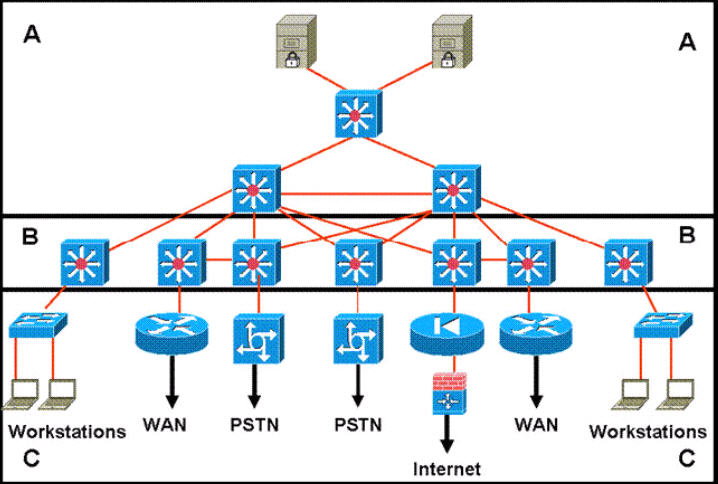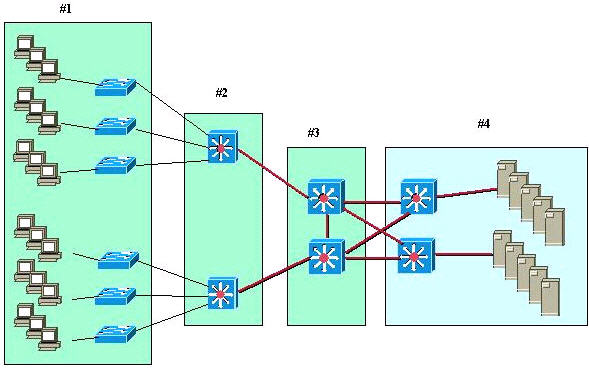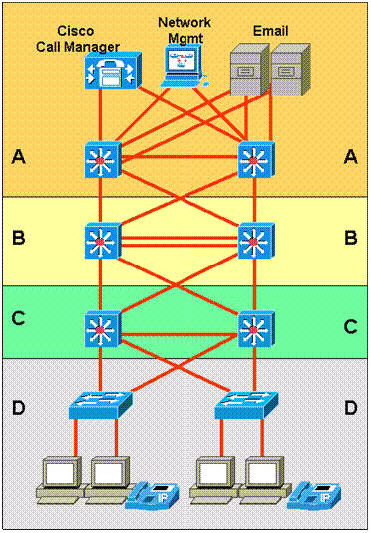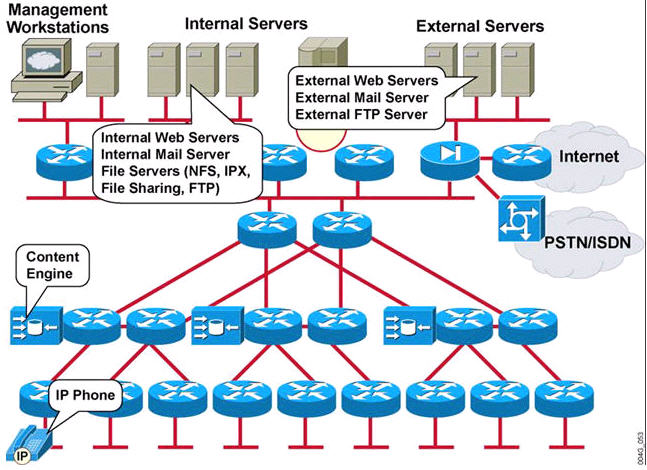Question 1
Which of these is the equation used to derive a 64 Kbps bit rate?
A. 2×8 kHz x 4-bit code words
B. 8 kHz x 8-bit code words
C. 2 x 4-bit code words x 8 kHz
D. 2×4 kHz x 8-bit code words
Answer: D
Explanation
While the human ear can sense sounds from 20 to 20,000 Hz, and speech encompasses sounds from about 200 to 9000 Hz, the telephone channel was designed to operate at about 300 to 3400 Hz. This economical range carries enough fidelity to allow callers to identify the party at the far end and sense their mood. Nyquist decided to extend the digitization to 4000 Hz, to capture higher-frequency sounds that the telephone channel may deliver. Therefore, the highest frequency for voice is 4000 Hz. According to Nyquist theory, we must double the highest frequency, so 2x4kHz = 8kHz.
Each sample will be encoded into a 8-bit code. Therefore 8kHz x 8-bit code = 64 Kbps (notice about the unit Kbps: 8kHz = 8000 samples per second so 8000 x 8-bit = 64000 bit per second = 64 Kilobit per second = 64 Kbps)
Note:
Nyquist theory:
“When sampling a signal (e.g., converting from an analog signal to digital), the sampling frequency must be greater than twice the bandwidth of the input signal in order to be able to reconstruct the original perfectly from the sampled version.”
Question 2
Which three of these are components of the North American Numbering Plan? (Choose three)
A. Numbering Plan Area
B. country code
C. prefix
D. zone
E. line number
F. trunk channel
Answer: A C E
Explanation
NANP has the address format of NXX-NXX-XXXX, where N is any number from 2 to 9 and X is any number from 0 to 9. The first three digits identify the numbering plan area and are commonly called the area code. The address is further divided into the office code (also known as prefix) and line number. The prefix is three digits, and the line number is four digits. The line number identifies the phone.
Question 3
A customer has the following Enterprise Campus design requirements:
at least 10 Gbps of bandwidth
network runs of up to 40km
no concern for transmission medium cost
Which transmission medium should you recommend to this customer?
A. shielded twisted pair
B. unshielded twisted pair
C. multimode fiber
D. single-mode fiber
E. wireless
Answer: D
Explanation
Below is the comparison of transmission media
Question 4
In the Cisco branch office design, what categorizes an office as large?
A. between 50 and 100 users and a three-tier design
B. between 50 and 100 users and a single-tier design
C. between 100 and 200 users and a two-tier design
D. between 100 and 200 users and a three-tier design
E. over 200 users and a two-tier design
Answer: D
Question 5
Which layer is the distribution layer?
 A. Layer A
A. Layer A
B. Layer B
C. Layer C
D. Layers A and B form a consolidated core and distribution layer
Answer: B
Question 6
Which two implementation plan principles best describe how to deal with potential failures?(Choose two)
A. A good implementation plan.
B. A successful test network test.
C. A test should be included at every step.
D. A detailed rollback procedure for each implementation step.
E. A table of failure points, rollback steps, and estimated rollback times.
Answer: C D
Question 7
Refer to the exhibit.
 A standard, Layer 2 campus network design is pictured. Which numbered box represents the distribution layer?
A standard, Layer 2 campus network design is pictured. Which numbered box represents the distribution layer?
A. #1
B. #2
C. #3
D. #4
Answer: B
Question 8
Which three pieces of information should be documented for each step of each phase in a design implementation plan? (Choose three)
A. step description
B. design document references
C. easy guidelines in case of failure
D. estimated implementation time
E. simple implementation guidelines
F. estimated rollback time in case of failure
Answer: A B D
Question 9
Which three terms describe the primary functions of the distribution layer of the campus network design hierarchy? (Choose three)
A. provides end-user connectivity
B. provides high speed transport
C. provides QoS services
D. enforces security policies
E. provides WAN connections
F. connects access devices to the core backbone
Answer: C D F
Question 10
Refer to the exhibit
 Which two statements correctly identify the layers of the Enterprise Campus module? (Choose two)
Which two statements correctly identify the layers of the Enterprise Campus module? (Choose two)
A. A is the Server Farm layer and C is the Campus Core layer.
B. A is the Server Farm layer and D is the Building Access layer.
C. B is the Campus Core layer and C is the Building Distribution layer.
D. B is the Building Distribution layer and C is the Campus Core layer.
E. A is the Internet Connectivity layer and B is the Campus Core layer.
F. B is the Building Distribution layer and D is the Building Access layer.
Answer: B C
Question 11
Refer to the exhibit.

Question 12

Question 13
Which of these is the equation used to derive a 64 Kbps bit rate?
A. 2×8 kHz x 4-bit code words
B. 8 kHz x 8-bit code words
C. 2 x 4-bit code words x 8 kHz
D. 2×4 kHz x 8-bit code words
Answer: D
Explanation
While the human ear can sense sounds from 20 to 20,000 Hz, and speech encompasses sounds from about 200 to 9000 Hz, the telephone channel was designed to operate at about 300 to 3400 Hz. This economical range carries enough fidelity to allow callers to identify the party at the far end and sense their mood. Nyquist decided to extend the digitization to 4000 Hz, to capture higher-frequency sounds that the telephone channel may deliver. Therefore, the highest frequency for voice is 4000 Hz. According to Nyquist theory, we must double the highest frequency, so 2x4kHz = 8kHz.
Each sample will be encoded into a 8-bit code. Therefore 8kHz x 8-bit code = 64 Kbps (notice about the unit Kbps: 8kHz = 8000 samples per second so 8000 x 8-bit = 64000 bit per second = 64 Kilobit per second = 64 Kbps)
Note:
Nyquist theory:
“When sampling a signal (e.g., converting from an analog signal to digital), the sampling frequency must be greater than twice the bandwidth of the input signal in order to be able to reconstruct the original perfectly from the sampled version.”
Question 2
Which three of these are components of the North American Numbering Plan? (Choose three)
A. Numbering Plan Area
B. country code
C. prefix
D. zone
E. line number
F. trunk channel
Answer: A C E
Explanation
NANP has the address format of NXX-NXX-XXXX, where N is any number from 2 to 9 and X is any number from 0 to 9. The first three digits identify the numbering plan area and are commonly called the area code. The address is further divided into the office code (also known as prefix) and line number. The prefix is three digits, and the line number is four digits. The line number identifies the phone.
Question 3
A customer has the following Enterprise Campus design requirements:
at least 10 Gbps of bandwidth
network runs of up to 40km
no concern for transmission medium cost
Which transmission medium should you recommend to this customer?
A. shielded twisted pair
B. unshielded twisted pair
C. multimode fiber
D. single-mode fiber
E. wireless
Answer: D
Explanation
Below is the comparison of transmission media
| Media | Bandwidth | Distance |
| Twisted pair | Up to 1 Gbps | 100 m |
| Multimode fiber | Up to 1 Gbps | 2 km (FE) 550 m (GE) |
| Single-mode fiber | 10 Gbps | 90 km (FE) 40 km (GE) |
| Wireless | 54 Mbps (27 Mbps effective) | 500 m at 1 Mbps |
In the Cisco branch office design, what categorizes an office as large?
A. between 50 and 100 users and a three-tier design
B. between 50 and 100 users and a single-tier design
C. between 100 and 200 users and a two-tier design
D. between 100 and 200 users and a three-tier design
E. over 200 users and a two-tier design
Answer: D
Question 5
Which layer is the distribution layer?

B. Layer B
C. Layer C
D. Layers A and B form a consolidated core and distribution layer
Answer: B
Question 6
Which two implementation plan principles best describe how to deal with potential failures?(Choose two)
A. A good implementation plan.
B. A successful test network test.
C. A test should be included at every step.
D. A detailed rollback procedure for each implementation step.
E. A table of failure points, rollback steps, and estimated rollback times.
Answer: C D
Question 7
Refer to the exhibit.

A. #1
B. #2
C. #3
D. #4
Answer: B
Question 8
Which three pieces of information should be documented for each step of each phase in a design implementation plan? (Choose three)
A. step description
B. design document references
C. easy guidelines in case of failure
D. estimated implementation time
E. simple implementation guidelines
F. estimated rollback time in case of failure
Answer: A B D
Question 9
Which three terms describe the primary functions of the distribution layer of the campus network design hierarchy? (Choose three)
A. provides end-user connectivity
B. provides high speed transport
C. provides QoS services
D. enforces security policies
E. provides WAN connections
F. connects access devices to the core backbone
Answer: C D F
Question 10
Refer to the exhibit

A. A is the Server Farm layer and C is the Campus Core layer.
B. A is the Server Farm layer and D is the Building Access layer.
C. B is the Campus Core layer and C is the Building Distribution layer.
D. B is the Building Distribution layer and C is the Campus Core layer.
E. A is the Internet Connectivity layer and B is the Campus Core layer.
F. B is the Building Distribution layer and D is the Building Access layer.
Answer: B C
Question 11
Refer to the exhibit.

Which statement accurately represents the characteristics of the core layer in this design?
A. QoS should be performed only in the core.
B. Load balancing should never be implemented or used in the core.
C. Access lists should be used in the core to perform packet manipulation.
D. It is acceptable to use a partial mesh in the core if it is connected to each device by multiple paths.
B. Load balancing should never be implemented or used in the core.
C. Access lists should be used in the core to perform packet manipulation.
D. It is acceptable to use a partial mesh in the core if it is connected to each device by multiple paths.
Answer: D
Question 12
Refer to the exhibit

Which element or elements of the existing network infrastructure does this network map emphasize?
A. network services
B. network protocols
C. the OSI data link layer
D. network applications
B. network protocols
C. the OSI data link layer
D. network applications
Answer: D
Question 13
Which two of the following are benefits of using a modular approach to network design? (Choose two)
A. improves flexibility
B. facilitates implementation
C. lowers implementation costs
D. improves customer participation in the design process
B. facilitates implementation
C. lowers implementation costs
D. improves customer participation in the design process
Answer: A B
